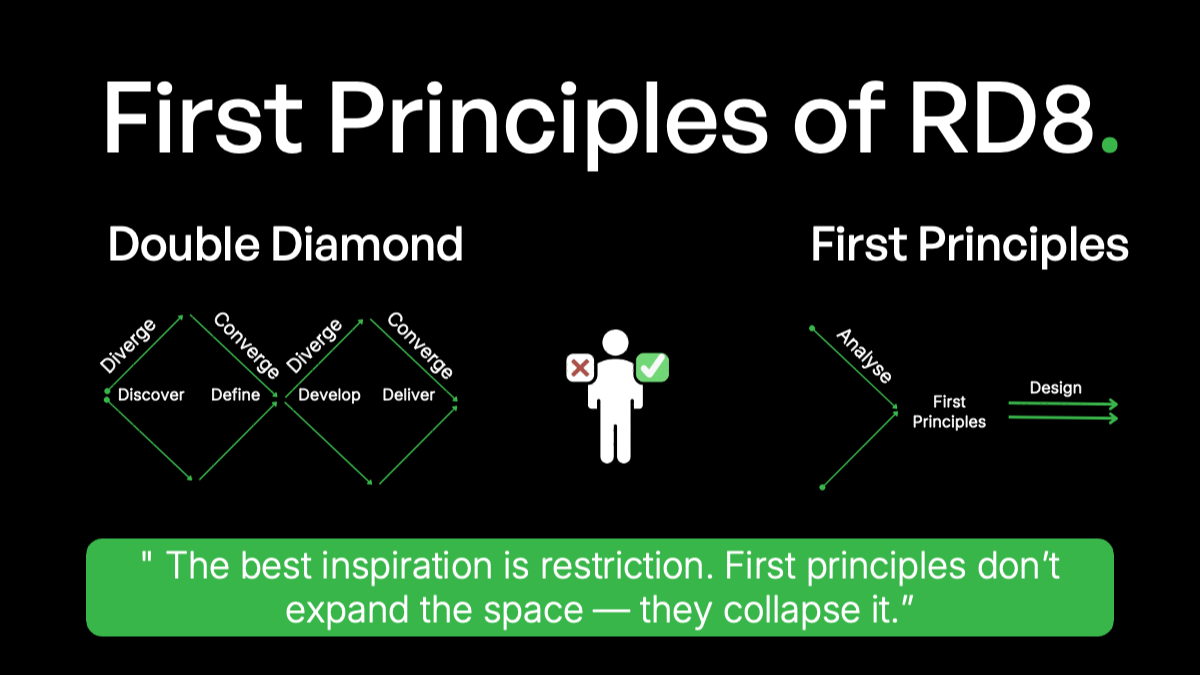Why RD8 Designs from First Principles (and Why You Should Too)
At RD8, we adhere to Axiomatic Design to such an extent that we hardly really think about it. This methodology says: minimize information and maintain independence of functional requirements. For those unfamiliar with the topic, here are a few practical examples:
- Product architecture: This means having one path for each tolerance stack. If you have more, you don’t know which one is relevant.
- Interface design: This means striving to have one contact surface for each single degree of freedom.
- Contact surfaces: This means zero draft and as small an area as possible.

I was reminded of this following the recent appearance of the Seneca keyboard from Norbauer & Co. in an article in The Verge in which First Principles were mentioned. It felt like a good time to write up our view on this subject.
Guiding Design Through Intelligent Goals
Designing from first principles is a powerful tool if you want to create a truly novel solution to a known problem. Rene Descartes, French philosopher and scientist embraced this approach with a method now called Cartesian Doubt in which he would “systematically doubt everything he could possibly doubt until he was left with what he saw as purely indubitable truths.”
We designers use this to logically deduce whatever principle you can that you know for sure will guide your design in the right direction and then build your solution from that.
First principles are foundational laws from which further reasoning is derived - for example Newton’s laws of conservation of energy. Axioms, on the other hand, are foundational statements that are assumed to be true within a certain system. This is not a discussion on the difference between first principles and axioms – the terms are often used interchangeably. It will be sufficient to mention that first principles are derived from analysis and observations and axioms are postulates.
In product development, you use this to describe an idealized state that isn’t necessarily obtainable in its pure sense, but it serves as an ambitious target to guide you through the “desert” without going in circles.
This logical approach challenges what I was taught in Conceptualization class at university: to make as many solutions as possible and then rank concepts based on subjective (occasionally random) parameters. AKA the double diamond.
Double Diamond and Design Thinking
Engineering tradition says you should unfold the solution space, make an idea catalogue without prejudice and restrictions, rate solutions and select the best candidate. It involves the two mental exercises.
- Divergent thinking: Generating as many ideas as possible (brainstorming, design studios, crazy 8s).
- Convergent thinking: Narrowing down and prioritizing ideas based on criteria like user value, feasibility, and business impact. But most often: best person’s best guess – AKA gut feeling.
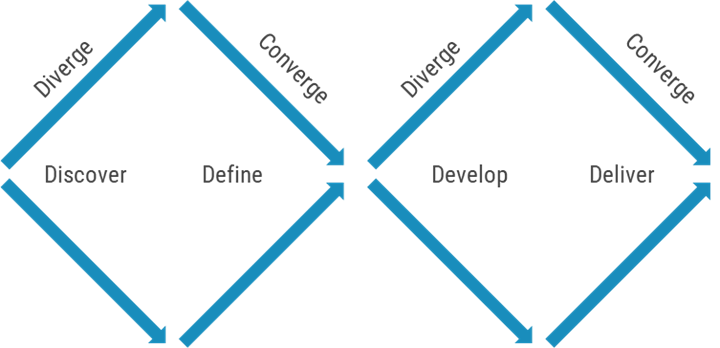
Our objection to this approach is that the best stimulation to inspiration is restriction. Tell someone they have endless opportunity and ask them what they want – they will have a hard time coming up with an answer. Give them a tough challenge and they become creative. Barry Schwartz has written an excellent book on the subject called ‘The Paradox of Choice’. The consequence is that without strong boundary conditions engineers will either be unable to diverge or the diverging will be sporadic. And if the converging is not data-driven selected concepts might throw R&D down a wrong path.
Under competent leadership, Design Thinking and Double Diamond certainly have their place. But we see again, and again massive resource wasted in committees, unfocused development, trial and error and intangible processes.
Consultants are often presented with a very tough problem that needs a solution – the task is not so much to ideate a lot, but to think hard about what the essence of the problem is and then make a focused design effort that solves for exactly that. For those challenges identifying first principles is an effective approach.
First Principles of Faucets
Say you set out to design a shower faucet. Through a series of questions, you arrive at the first principles of faucets: flow and temperature are unrelated properties that a faucet regulates. Based on this we formulate the design driver, or rules, of our design: The more control over the flow and temperature the user has, the better. We can now postulate that the perfect faucet lets you set flow and temperature independently at once and it must self-regulate those levels until you turn it off. This is a useful guiding star. While abstract, it will guide the design process and lead to focused problem solving, better products and shorter development time. Anyone who has tried a shower with a temperature regulator knows this principle to be true.
First Principles Design – Breaking It Down
The challenge is, through analysis, to sort through all the requirements, stakeholder opinions and your own prior experiences. This analysis typically belongs to the first part of the concept phase or even pre-project phase. It leads to this:
- First principle: The fundamental laws of physics that reign over your solution space.
- Design drivers: The parameters that make up the characteristics of the ideal solution which we seek to optimize and solve for. If you wanted, you could call design drivers a type of axioms for your specific design.
- Guiding star: An abstract description of the idealized product that fulfils the first principles. It should be seen as that materialization of your idea hovering over the horizon in a divine glow that all your efforts strive towards arriving at.
Once you have that abstract fundamental principle in place then it is typically straight forward to synthesize a solution that solves for and optimizes this principle. You build CAD models, allocate tolerances necessary to achieve design goals, describe test programs, and develop sourcing strategies. For sure, there will be compromise, but at least you are making those compromises consciously.
So, it’s not as abstract as it sounds. The first principles approach instead of expanding the solution space collapses it to a point of clarity which is the first principle, and then the solution develops from that.
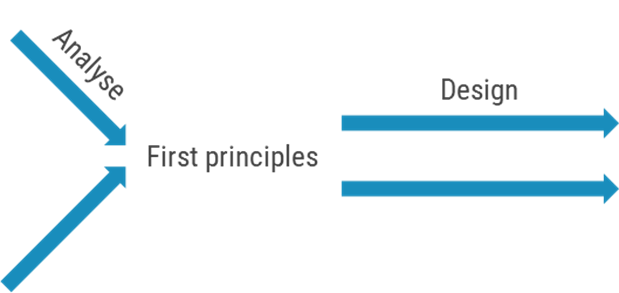
A Stabilizer from First Principles
A colleague of mine once told me that solving any engineering problem was about finding out what the design conflict or optimization dilemma really is. For airplanes, you want them light and strong. For laptops you want computing power and long battery life. If you are familiar with the TRIZ methodology, this will resonate with you.
Designing a space bar stabilizer, you soon come to realize that the optimization dilemma stands between two design requirements:
- Minimum mechanical resistance
- Zero rattling
It is fairly easy to design something that is acoustically silent by designing all interfaces with preload features. Alas, it introduces exactly that, a preload – the very other thing we want to avoid. Conversely, it is also fairly easy to design something friction-free by careful location of kinematic constraints, clearance and bearing ratios. But that clearance is exactly the thing we wanted to get rid of to mitigate rattling. And since compromise is not an option, we find ourselves with an interesting challenge.
Zero rattling
Let’s take the second requirement first and try to understand what rattling is: rattling is the acoustic response to a solid volume impacting another solid volume. The impact produces a soundwave which is undesirable for high end computer keyboards. That is, except the deliberately engineered acoustic response which is the characteristic sound design of the product – just think of acoustic engineering of high-end car doors.
An impact is the consequence of a relative velocity rapidly coming to a halt. And for that to happen an acceleration over a distance must have preceded the event. Therefore, we must be able to reduce the acoustic response, impact energy and ultimately velocity by either reducing the magnitude of acceleration or distance over which it built up velocity. The accelerations are a circumstance given by user input and spring upstroke – changing these are not obviously possible. Therefore, it Is logical to direct attention to the distance of travel.
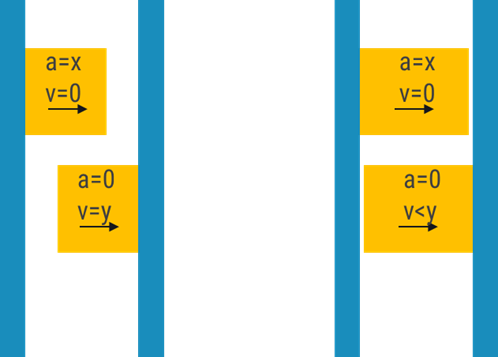
We see now a first principle is emerging: Rattling is a consequence of play. The ultimate solution has zero play, and any design choice that leads to less play, will increase quality of the solution. Zero play is our design driver.
- Design driver 1: Reduce all play as much as possible.
Analysing tolerance stacks one quickly realize that the minimum amount of play is related to dimensional variation which is controlled by tolerances. This is a first principle as well: play is driven by dimensional variation. In manufacturing in general, but particularly injection molding, dimensional variation is a function of size. For example in tolerance class IT10 the expected variation for a 2mm feature dimension is +/-0,05 while for 20mm it is +/-0,12.
- Design driver 2: Make fit geometry dimensions as small as possible.
Minimum resistance
Resistance in a moving mechanism can be boiled down to a first principle: Friction is energy dissipation. Energy dissipation is measured in J/s and in Newtonian physics it is the product of force and velocity. This is enormously interesting because although we want to reduce forces it means that we can allow ourselves preload if only we can somehow reduce interface velocity.
- Design driver 4: reduce reaction forces.
- Design driver 5: reduce interface velocity.
The First Principle of Stabilizers
There is one special type of mechanical joint which under these circumstances solve for almost all of these design drivers: The pin joint.
- Steel pins are incredible precise machine elements. They basically short circuit all tolerance calculations by removing one half of the tolerance stack and all variation left is the plastic part – it inherently reduces play in the interfaces.
- Steel pins are incredibly strong compared to plastics allowing use of very small dimensions. Using ~1mm pins effectively reduces molding variation to the mold-maker’s machining precision.
- The lowest frictions you can find outside the more exotic parts of engineering is between plastics and steel – most markedly you typically find that stick-slip is less of an issue.
- Using pin joints to produce a linear motion opens up for the possibility of gearing the motion. Just consider a door – the handle moves at high speed by the relative motion in the hinge is very small which is why even large doors can be operated with ease.
This, in a nutshell, is the reasoning that led to The Pin-joint Axiom: Pin joints run more smoothly than sliding ones.
Accepting that the argumentation is solid we took the leap and formulated a guiding star of the Norbauer Stabilizers: A stabilizer built using only pin joints.
The rest, as they say, is history – if you would like to read more then Ryan Norbauer have written engagingly about the windy road of the stabilizers.
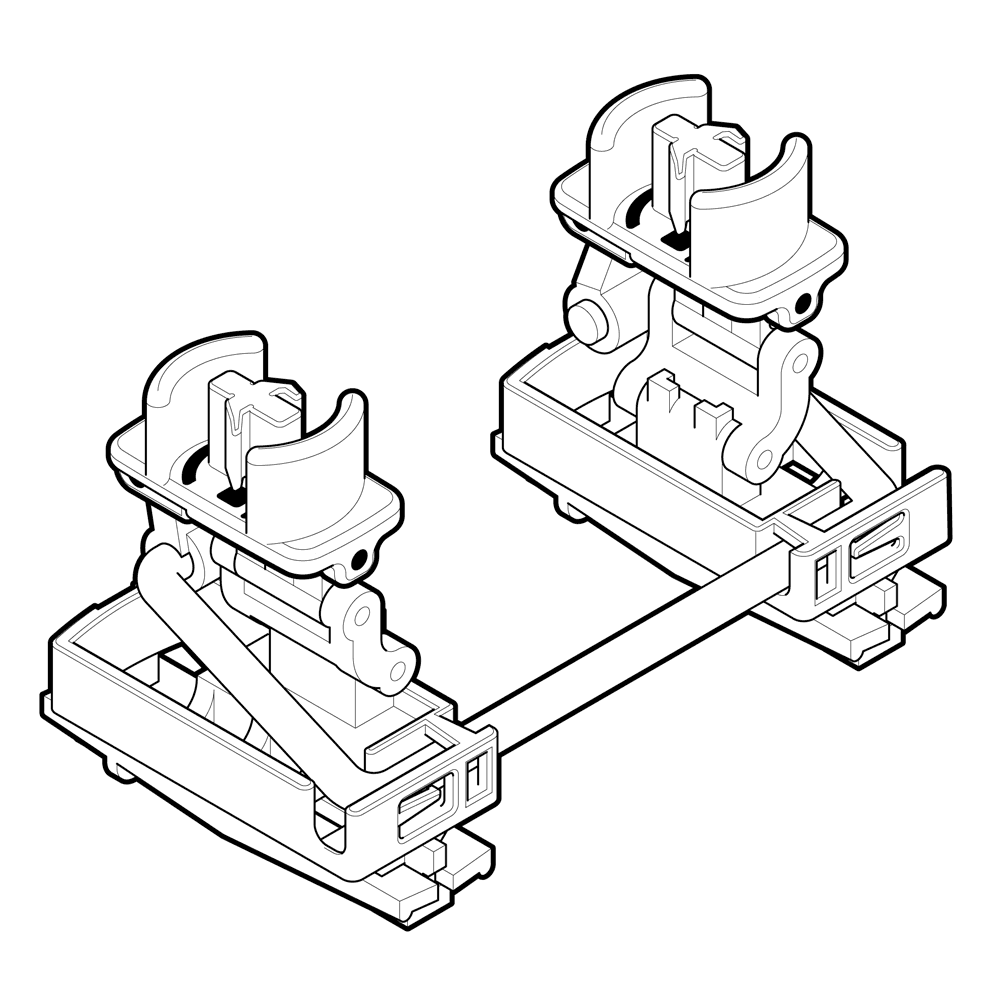
A closing remark
In our experience, the best way to think outside the box is to force yourself to formulate what the ideal situation would be and make it data-driven. It serves three purposes.
- It forces you to focus instead of speculating which anyone can do.
- The act of setting up restrictions for yourself is stimulating to creativity.
- Having ambitious targets makes you develop faster.
Please reach out if you would like to hear more.
